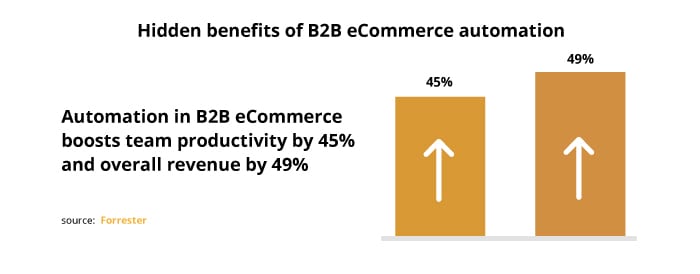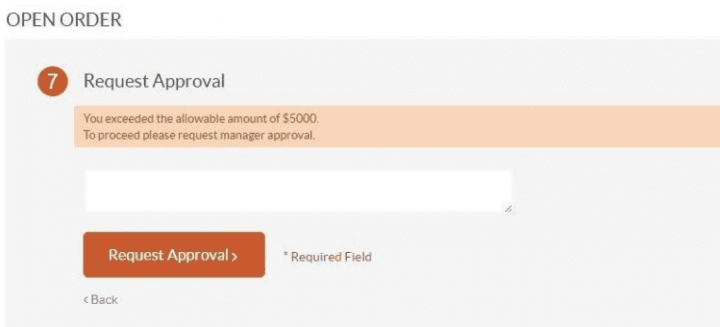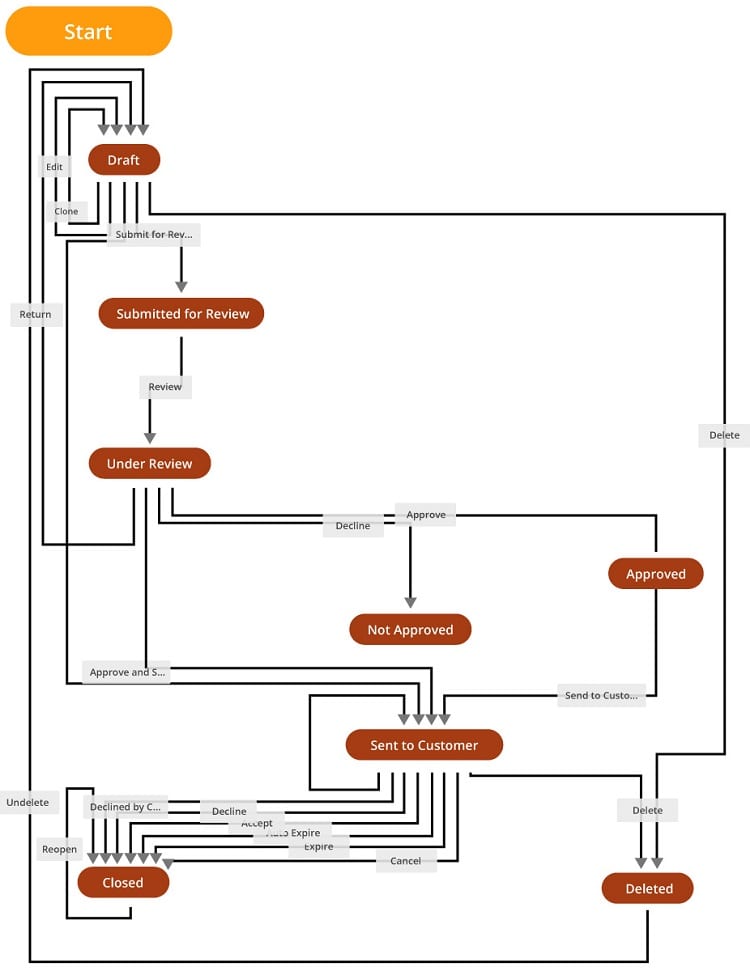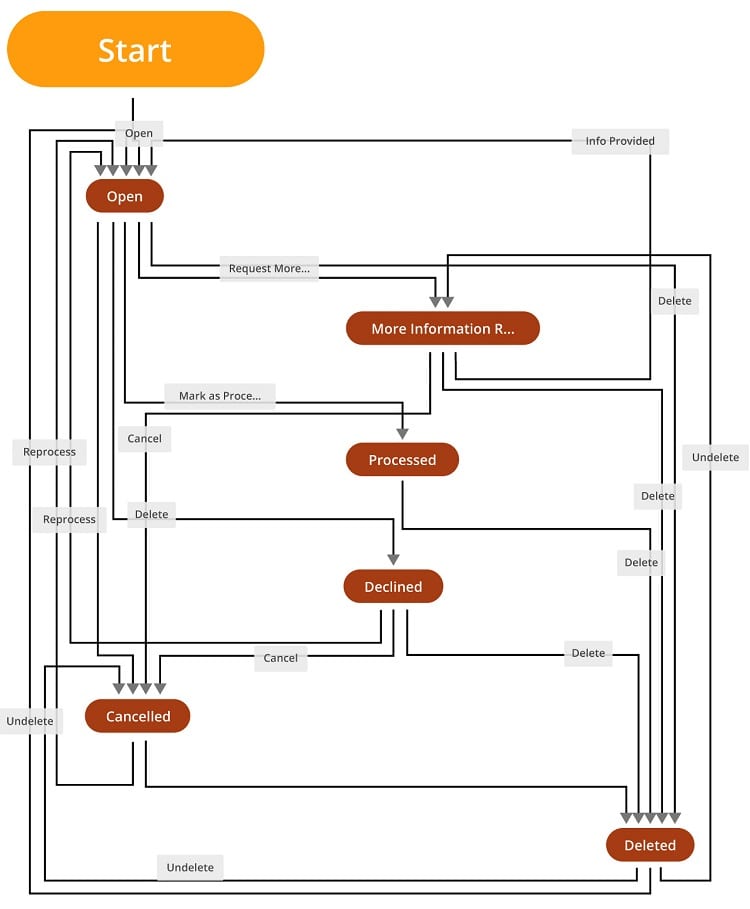Many B2B eCommerce brands have implemented automation in response to remote work environments, supply chain crises, or customer service streamlining.
However, forward-thinking B2B companies seek flexibility within their workflows to experiment and unlock new ways of gaining long-term stability. This approach provides peace of mind that they can better weather unknown risks and capitalize on opportunities faster.
According to Oro’s research, B2B sellers aim to improve productivity through automation and encourage their employees to build relationships instead of manually processing orders. As a result, flexible workflows benefit both B2B sellers and buyers. Users can access personalized pricing and track their orders without employee involvement, while brands can run their stores on autopilot 24/7.

Implementing workflow automation yields time and cost savings while boosting productivity. Moreover, it minimizes errors, streamlines approval processes, and fosters accountability.
What Is an Automated Workflow in eCommerce?
A workflow is a sequence of steps in a business process that involves managing data and information to achieve a business goal, such as reducing costs, manual effort, or optimizing resources.
Workflow automation refers to automating these processes to increase speed and accuracy while eliminating errors associated with manual data entry or missing data. In most cases, automating workflows involves replacing a human activity with a digital one.
For instance, automatic customer data synchronization between the CRM and the B2B eCommerce platform is an example of simple B2B workflow automation. With proper setup, it eliminates manual order entry and coordination tasks by sales representatives.
4 Advantages of Implementing Workflow Automation in B2B eCommerce
There are many reasons why you might want to automate workflows in eCommerce B2B processes. Explore the primary benefits of implementing workflow automation in eCommerce:
Ensure data accuracy
In eCommerce, businesses often generate vast volumes of new customer, inventory, or transactional data. Manual handling of this data can result in delays or omissions, potentially causing missed sales opportunities.
As data accumulates, it tends to fragment across different storage locations or might be misplaced, complicating operational efficiency. Despite robust processes, human involvement introduces the risk of errors. Workflow automation significantly reduces or eradicates these concerns altogether.
Decrease costs
Automating manual tasks enables businesses to execute them swiftly and accurately. For instance, if an eCommerce representative spends 30 minutes daily manually handling orders, automating this process would save them 130 hours annually. When scaled across a team of 10 representatives, these savings become significantly more substantial.
The saved time, money, and effort can create a ripple effect across various business domains. This includes allocating more time for employees to focus on customer service, conduct market research, analyze competitors, perform A/B testing, engage in experimentation, and explore innovative tactics for business growth.
Expand your business
Scaling your eCommerce business can be challenging, especially when you’re bogged down by repetitive tasks. Manual data entry and email communication can be time-consuming and error-prone, which can divert your employees’ attention from more important business growth initiatives.
By automating these tasks, you can free up your human assets to focus on more productive activities that can help increase revenues and act on growth opportunities.

Enhance customer experience
Customers are increasingly comfortable with purchasing without the intervention of sales representatives. However, they also expect a seamless and intuitive B2B buying experience. By customizing products, order data, and shipping information to their needs, customers feel valued and appreciated.
Workflow automation can help eCommerce businesses introduce self-service elements that enable customers to purchase, manage their orders, and return items without staff involvement. This not only saves time and effort for customers but also encourages them to return for more purchases.
How to Implement B2B eCommerce Workflow Automation for Your Business
Determining which business processes to automate can be a challenge. Here are initial steps for effective workflow orchestration in eCommerce:
Identify repetitive tasks
Compile a list of tasks ripe for automation, particularly those that are repetitive and resource-intensive. Tasks involving data handling, such as reporting, emailing, coordination, confirmation, reminders, and various data entries, often fall into this category.
Evaluate and refine your processes
After pinpointing tasks for automation, assess your processes. While some areas might be evident for automation (like email or data reporting), deeper investigation may be required. Engage with employees and leverage activity tracking tools to identify and eliminate bottlenecks.
Start with simplicity, scale gradually
Commence automation with workflows that minimally impact operations. Starting with simpler processes allows for learning and mastery before tackling more intricate ones. Seek an eCommerce solution equipped with appropriate automation features and necessary integration connectors between systems. Ensure data accuracy through vigilant monitoring during the assessment phase.
9 Best & Must-Utilize B2B eCommerce Automation Workflows
While numerous B2C operations are rather straightforward, B2B eCommerce transactions hold higher value, entail longer processes, and engage multiple decision-makers. Consequently, the scope for workflow automation is considerably more extensive. Here are several business processes within B2B eCommerce that derive substantial benefits from automation:
Product data
Manual data entry is a time-intensive task prone to numerous errors. With the expansion of product options and catalogs, overseeing product configurations, descriptions, specification sheets, and similar details becomes increasingly challenging.
Utilizing a unified, cloud-based repository for managing product information across systems aids in maintaining organized and accurate product data.
Order automation
When a B2B customer initiates an order on your website, numerous backend processes are set in motion. This includes data transmission to the ERP, inventory updates, and customer notification via email – all of which require automation. Given the involvement of multiple systems, your workflows need strong connections spanning CRM, ERP, accounting, payment, and shipping providers.
Synchronized Inventory Management
Efficiently managing inventory stands as a pivotal function within eCommerce. Considering vast product catalogs, B2Bs must meticulously align their stock with demand, avoiding both shortages and excesses.
For instance, inventory automation tools facilitate the following workflow:
- Your sales automation system registers a new order.
- The inventory management software allocates stock to the order, offering rule-setting options to ensure optimal warehouse or store utilization.
- Warehouse or store is utilized.
- The order in your system is tagged as ‘ready for dispatch.’
- Warehouse teams pick, pack, and dispatch the order.
- The system logs stock removal, maintaining precise inventory levels.
- Automated notifications trigger when stock levels drop below a set threshold, with some systems capable of generating purchase orders from suppliers.
Efficient Customer Onboarding
B2B enterprises engaging diverse customers encounter varying vendor and supplier onboarding procedures, demanding input from decision-makers that necessitates synchronization. Without automation, essential elements like paperwork, training protocols, compliance measures, and email sequences risk disarray. Automating these stages allows employees to prioritize time-sensitive tasks, such as addressing customer concerns.
Targeted Customer Segmentation
Personalization, a necessity in B2B, relies on scalable automation. CRM and eCommerce platform integration facilitate accurate execution of focused marketing endeavors.
For instance, identifying buyers making bulk purchases of specific products or targeting specific business units within organizations for more effective marketing campaigns becomes achievable.
Automated Pricing
Automated pricing workflows offer advantages, reducing friction during the purchasing process, particularly for B2Bs managing extensive product catalogs and diverse customer bases.
Seek workflows that dynamically compute prices per customer, accommodating specific discounts, promotions, shipping, and other elements.
Streamlined Order Negotiation
B2B purchases revolve around quotes and invoices, often negotiated on an individual basis. B2B eCommerce workflow automation expedites quote requests, invoice management, and term negotiations, leveraging automated workflows for email notifications or updating approval statuses via the customer’s self-service portal.
Enhanced Approvals Management
Distinct from B2C eCommerce, business buyers operate on behalf of companies, navigating diverse corporate structures and purchasing approval processes. Automation facilitates notifications to decision-makers for purchase orders above predefined thresholds, ensuring automatic order fulfillment post-approval.
Optimized Returns Management
B2B enterprises maintain unique return, refund, and exchange criteria for individual customers. Automating these processes reduces errors, expedites returns, and elevates the customer experience. Moreover, seamless data flow between CRM, ERP, and eCommerce systems maintains customer activity and inventory visibility.
Instances of B2B eCommerce Workflow Automation
Order Approval Process
Let’s delve into an example of an order approval workflow within the checkout procedure. Typically, your checkout commences with a swift order form or a shopping cart checkout page. As the customer progresses through the steps, they submit an order. However, prior to finalizing payment or specifying shipping details, the customer might require approval from a higher authority, such as a purchasing manager or the accounting department.

Upon the customer selecting ‘request approval’, the relevant approving authority receives notification, offering the choice to either accept or reject the order. Following approval, the requester is automatically notified, and the order proceeds with normal processing. Here’s a glimpse into the mechanics of an automated workflow:

Quote Request Feature
Customers interested in bulk orders or recurring purchases often seek negotiable terms for specific products on your site. Incorporating a ‘request a quote’ button on your product pages allows automated workflows to manage subsequent processes. Additionally, this option can be tailored for specific products and customer segments. Here’s a potential representation on your website:

Upon the customer’s quote request, automated workflows activate discreetly. They may prompt for additional information from the customer, or alternatively, generate a quote based on the provided details. Consequently, human involvement becomes necessary only in exceptional circumstances.

Seek Integrated Workflow Automation in eCommerce Providers
To fully leverage the potential of eCommerce automation, adopting a comprehensive approach across the organization is crucial. Begin by assessing existing processes, establishing goals, securing stakeholder buy-in, and selecting the appropriate toolset.
When vetting B2B eCommerce vendors, prioritize their capacity for innate automation of B2B eCommerce workflows. Lack of a robust workflow automation engine at the outset may lead to reliance on workarounds and customized modifications, complicating operations and impeding scalability.
Fortunately, specialized B2B solutions like OroCommerce offer the resilience, adaptability, and security vital for businesses to position themselves advantageously for the future. Often, the primary barrier hindering B2Bs from embracing the advantages of B2B eCommerce workflow automation is initiating the initial steps.
Contact us via contact@ekino.vn to explore how we can assist you in automating your workflows using OroCommerce.
Note: Content for this post was originally posted on Oroinc.com
Original content page: https://oroinc.com/b2b-ecommerce/blog/workflow-automation-in-ecommerce/
Frequently Asked Questions
What encompasses B2B eCommerce workflow automation?
B2B eCommerce workflow automation involves leveraging automated technology and processes to refine and enhance the different stages within the B2B eCommerce cycle. This encompasses tasks like order processing, inventory management, shipping, payment processing, and customer service. The primary goal is to boost efficiency, minimize errors, and elevate the overall customer experience.
In what way does B2B eCommerce workflow automation enhance order management?
B2B eCommerce workflow automation enhances order management by optimizing order processing, inventory management, order tracking, and the shipping and delivery process. Additionally, it facilitates real-time insights into order statuses and inventory levels, empowering businesses to make informed decisions and optimize their overall operations.
How does B2B eCommerce workflow automation optimize the quoting and pricing process?
B2B eCommerce workflow automation streamlines the quoting and pricing process through the following methods:
- Automated Quoting: Upon a customer’s quote request, the B2B eCommerce system can instantly generate a quote using predefined pricing rules and customer-specific agreements. This real-time process ensures swift delivery of the quote to the customer.
- Approval Workflows: If quote approval from a manager or team member is necessary, the B2B eCommerce system automates this process. It triggers automated notifications to the relevant team members, facilitating online approval or rejection of the quote.
- Pricing Rule Customization: Configurable pricing rules within the B2B eCommerce system allow for varied pricing based on factors like customer order history, order volume, or specific product selections. This customization ensures customers receive accurate and competitive pricing.
Do specific challenges arise during the implementation of B2B eCommerce workflow automation?
Indeed, there are distinct challenges associated with implementing B2B eCommerce workflow automation. These challenges encompass aspects such as system and process integration with existing frameworks, maintaining data accuracy and uniformity across diverse systems, handling intricate pricing and discount structures, and ensuring compatibility with the distinct demands of B2B transactions, including purchase orders and invoicing.
Moreover, potential challenges might emerge from employee resistance rooted in familiarity with manual processes, necessitating training and change management efforts for successful adoption of the new system.







